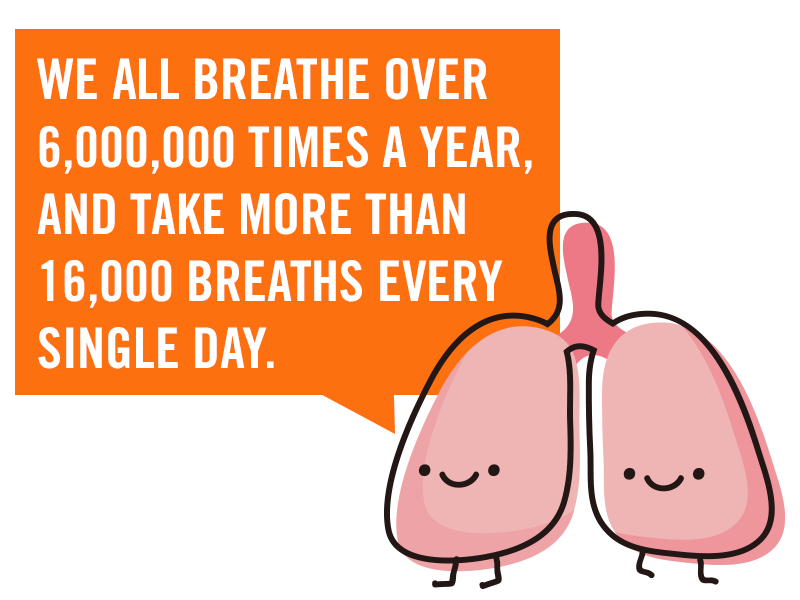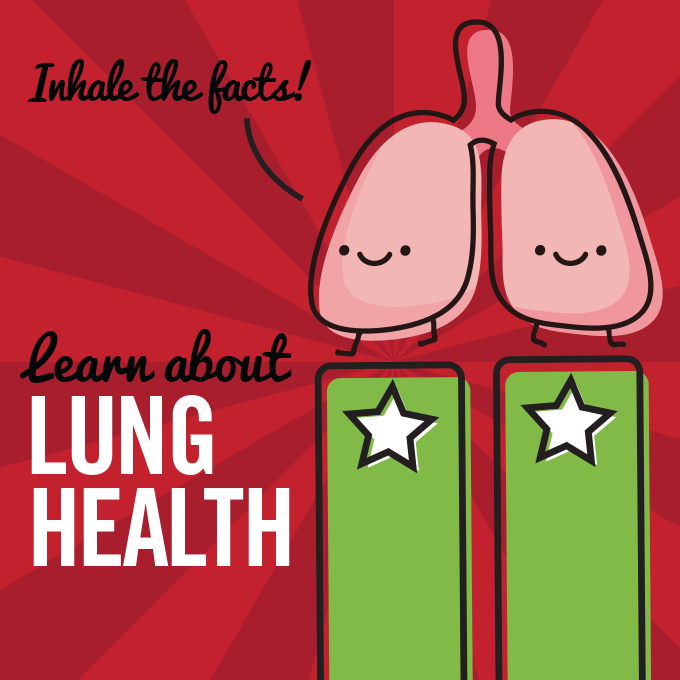You breathe over six million times a year. That’s over 16,000 breaths every day. A lot to take in? This is why it is so important to keep your lungs in the best shape possible.
How do the lungs work?
We all know that the lungs are part of the respiratory system, but they are probably more intricate than you would have imagined. For example, did you know that the lungs aren’t identical? Each lung is in fact divided into sections known as lobes, the right being made up of three lobes and the left, two. This makes the left lung smaller and narrower, but in order to accommodate the diaphragm, the right lung is actually five centimeters shorter. When you breathe in through your mouth or nose, the air enters your trachea, splitting into the two bronchial tubes (or bronchi), which connect to each lung. This then splits further into each lobe, then into tiny bronchioles, which end in clusters called alveoli, of which there are over three hundred million. The lobes are made of a spongy tissue, which expand and contract as you breathe.
In order for your body to function correctly, every cell needs to have access to oxygen. Once the oxygen enters your lungs, it is taken through the bloodstream to every other part of your body, where it is exchanged for carbon dioxide, which is exhaled as waste. As well as being in charge of your oxygen intake, the lungs also protect your body from harmful bacteria. Mucus exists in the bronchial tubes in order to catch dust and germs that attempt to get into your system, which is then naturally rid of by coughing, sneezing or swallowing.
Lung disease
Like all of the organs in the body, anyone can develop issues or potentially diseases related to the lungs. These conditions can affect the bronchioles, the alveoli, lung lining or chest wall. Here are some of the most common ones:
Asthma
Asthma is a type of chronic disease that affects the function of the bronchial tubes. Those with asthma will have inflamed airways, which become more swollen and tight when something affects their breathing, such as stress, illness and more often than not, when exercising. This presents itself in the form of wheezing, shortness of breath, chest tightness, or coughing. There is no current cure for asthma, but symptoms can be improved by medication or an inhaler. These are designed to open up the airways and relax the muscles in the bronchial tubes. On the first Tuesday of every May, the Global Initiative for Asthma organises its annual World Asthma Day event. Visit their page for more information on asthma awareness and care.
Cystic Fibrosis
A genetic disease found in 1 in 25 people, cystic fibrosis affects the cells which are in charge of producing not only sweat and digestive fluids but mucus as well. Mucus becomes thicker and stickier, making it difficult for the body to clear it like it should. Cystic fibrosis is usually quite painful, with discomfort in the chest and abdomen, as well as nasty coughs and gastro issues. The shortened life expectancy makes it crucial for cystic fibrosis sufferers to keep their lung function as good as they possibly can. May is National Cystic Fibrosis Awareness Month; find out more about the condition on the Cystic Fibrosis Foundation’s website.
Pneumonia
Pneumonia is an infection of the lungs, where the alveoli inflame due to filling with fluid. It starts when you breath germs into your lungs and can develop in the form of a cough, fever or chills after a cold or flu. Although Pneumonia generally only lasts for a few weeks at most, treated with antibiotics or vaccines, it can be very dangerous in the young or elderly.
Put it to the test
Spirometry is a very simple test offered by doctors which helps detect many lung conditions including asthma, cystic fibrosis, pulmonary fibrosis and COPD. You will be asked by your doctor to breathe into a tubular device called a spirometer, in order to determine how much air you exhale in one forced breath. It is important that you are able to spot the warning signs of a lung condition early, so if you have had a cough for a long time, feel breathless, are a smoker or are over the age of 35, spirometry would be a good test to enquire about.
Let’s get physical!
Although some infections and diseases can’t be avoided, the best way to avoid any lung-related illness is to make your lungs strong. Exercise is the absolute best way of doing this, and some exercises are particularly good for the lungs.
Breathe in the air
For every form of exercise and activity, you need a good set of lungs, and improving your lung capacity will in turn improve your performance. Simple practice of deeper breathing will help you use more of your lung’s capacity and oxygenate your blood better. Try and take a deep breath now; place your hand on your diaphragm (just underneath your rib cage) and feel it lowering when you inhale and lifting when you exhale through your nose. This may be opposite movements to what you would expect, but in order to breathe deeply, you should be focusing on opening up and relaxing your lungs, rather that making your body tenser and tighter. You can also help to oxygenate your blood by laughing more, which will also give your abs a good workout too.
Aerobics
Have you ever found when starting out with cardio or aerobic exercise that you find yourself short of breath, but in time, you feel less winded? This is an example of your lungs improving in strength, and being able to deliver oxygen to your tissues more quickly and effectively. If you like working out in the gym, try running, cycling, weight training, or interval training. This means you are putting more effort in, but in shorter bouts, so in time, both your heart and your lungs will strengthen. You’ll be able to track your improvement by how quickly you recover between intervals.
Swimming
Aerobic activities don’t only take place on solid ground. Jump in that pool and enjoy an aqua aerobics class as well. If classes aren’t your thing, however, swimming lengths is a great way to work on controlling your breathing and increasing lung capacity. All strokes apply, and again, an interval-style approach will maximize your results.
A bigger bounce!
Fancy something a bit different? Why not add a trampoline to your fitness regime? “Rebounding”, not to be confused with its usual meaning, is the name given to exercises that take place on a trampoline. With every bounce, you are working against gravity, and encouraging your muscles to react even harder to your movements (with up to three times more force). This not only improves your lung fitness, but heart strength and balance too. Jump jogging, jump dancing or simply just jumping; release your inner child!
Say no to smoking
We all know that smoking is bad for us, but do you know the direct damage that it can cause to your lungs? There are both long-term and short-term effects on your lungs when you smoke. The nicotine is what makes cigarettes addictive, but it’s the 4,000 chemicals that exist in cigarettes that cause most of the damage. First of all, the cells that produce the mucus in your lungs grow in both size and number, meaning more mucus is produced. Secondly, every cigarette smoked slows down and even removes the cilia, or little hairs that remove the mucus out of your lungs. The combination of these two factors means that the airways in your lungs are not cleaned out, which will lead to infection and inflammation.
Not only can smoking lead to the development of lung cancer, as the chemicals in cigarettes can change normal cells into cancerous cells, but it is the biggest cause of chronic obstructive pulmonary disease (COPD), a term used to describe a number of lung diseases.
According to the British Lung Foundation, smoking tobacco is the biggest avoidable cause of death, and no matter how long you have been smoking, it is never too late to stop. Giving up smoking not only reduces the risk of developing the diseases connected with it, but it also slows down the rate at which these diseases develop if you already have one of them.

Unfortunately it’s not only your lungs that you damage through smoking, but those around you as well, as over 10,000 people die in the UK from diseases linked to passive smoking every year. 31st May is the World Health Organisation’s World No Tobacco Day. If you need help quitting, contact your doctor or visit the NHS Smokefree website.
Something in the air…
Wherever possible, it is important to protect your lungs from exposure to air pollution. You can go to extreme measures to avoid air pollution, including downloading apps which tell you when there are high pollution levels in your area. However, a simpler way to fight harmful air would be to look at improving the quality of the air inside your home or at work. This could involve buying household products like paint or cleaning fluids, that contain less chemicals, or investing in an air purifier.
Feeding your lungs
Unfortunately, even with these protections in place, in a modern day world, it is hard to keep your lungs away from pollutants. However, we can help cleanse our lungs from the inside. Although it may not sound related, you can in fact adjust your diet to improve your lung health, particularly if you suffer from asthma. Here are some dietary factors that you could consider:
Antioxidants
Any food sources with antioxidant qualities will help your lungs, as antioxidants neutralize the free radicals in the body that help the muscles in the airways to contract and constrict smoothly. Antioxidant foods containing vitamin C and E are particularly good to look out for. See our article on detoxing for the top 10 choices in antioxidant foods.
Carotenoids
Carotenoid is a particular type of antioxidant. There is strong evidence that carotenoids have good benefits for the lungs, including reducing the risk of developing lung cancer. The beta-carotene contained in these foods is also converted to Vitamin A in the body, which can help prevent against asthma too. Foods that contain carotenoids are easy to remember, because as the name suggests, they usually have a bright orange or red hue. Carrots, pumpkins, papayas and red peppers are amongst them.
Helping herbs
Herbs are probably the easiest adjustment to make to your diet, but the little sprigs do pack a healthy punch. Rosmarinic acid is a substance that is known to improve the symptoms of asthma. It encourages cells to make prostacyclins that open up the airways. You can find rosmarinic acid in, you’ve guessed it, rosemary, but also peppermint, sage and oregano too.
Omega-3 fatty acids
Bad fats, like trans fats found in processed foods, are to be avoided if you have lung issues, as carrying excess weight will only worsen your asthma symptoms. However, some studies have suggested that eating healthy fats like omega-3 fatty acids will help. This is because when cells have enough omega-3, they produce a substance that can reduce inflammation. Although the evidence is only in its early stages, there are many health benefits to these foods, which include salmon, cod, and flaxseed.
Some people may worry that drinking or eating dairy products makes your body produce more mucus, but according to the British Lung Foundation, there is not enough scientific evidence to back this up. They suggest that if you think that they do have this effect, try rinsing your mouth out or drinking a small amount of water after consumption.
Enjoy a 3 Day Guest Pass, on us!
If you want to make your lungs stronger through exercise, why not take advantage of our fantastic offer? To claim, fill in your details here


















